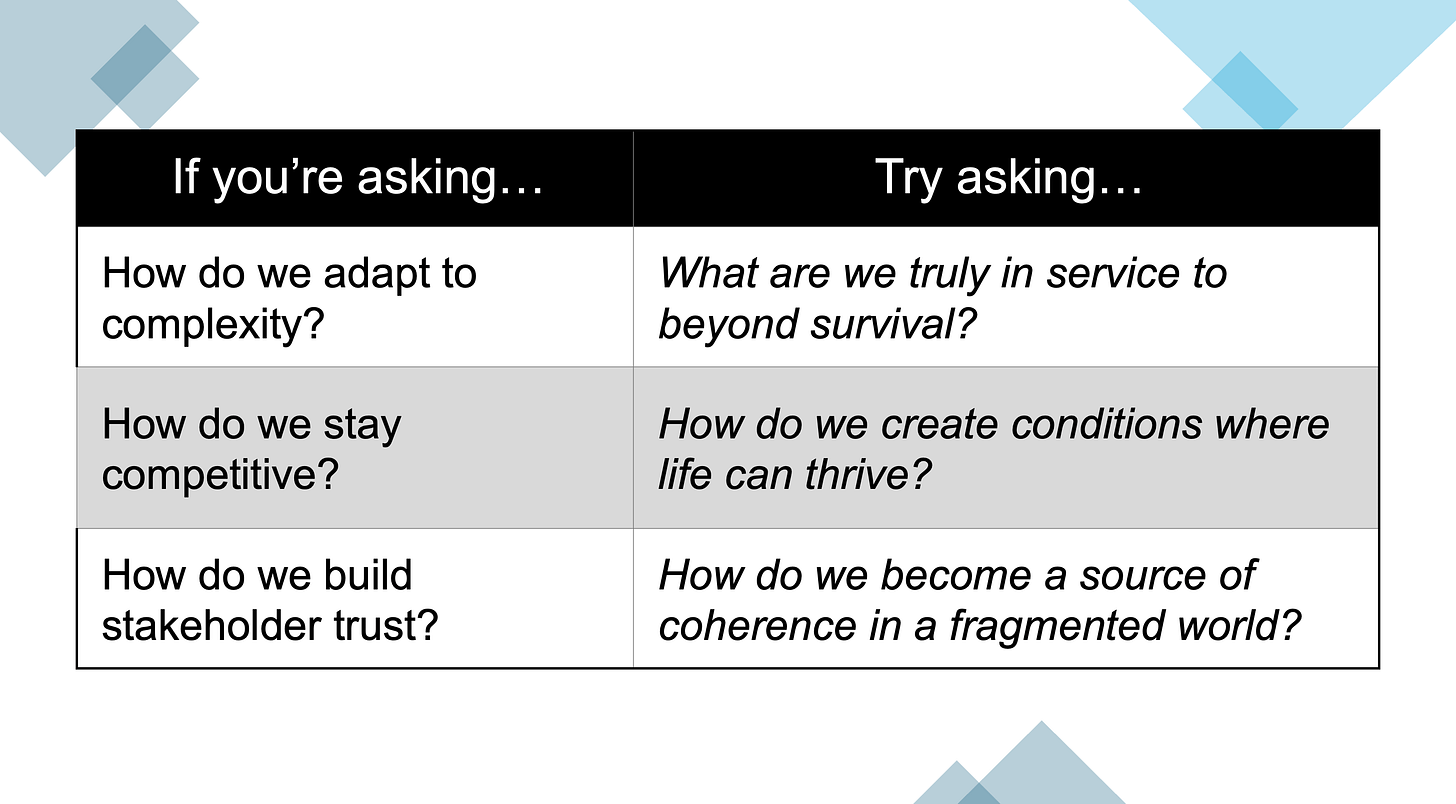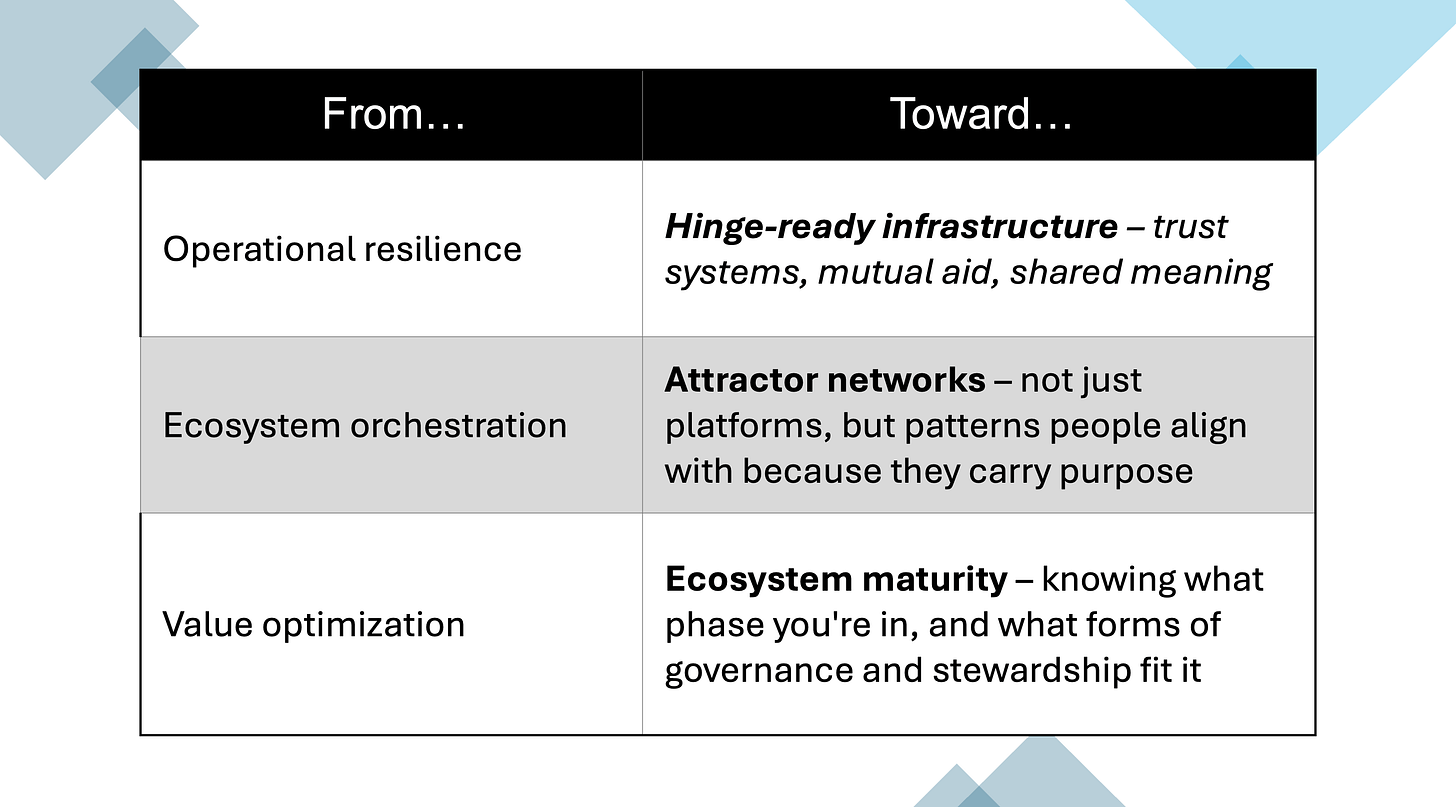I want to begin by expressing my deep appreciation for the team at Boundaryless. Their latest piece on regenerative organization development offers one of the clearest articulations I’ve seen of how organizations can begin to evolve toward more ecosystemic, value-aligned structures.
It lays out a practical and coherent progression—from enabling constraints, to ecosystem orchestration, to closed-loop value creation. These aren’t just abstract concepts—they’re design moves that many organizations can begin applying today.
It’s a timely and thoughtful contribution that meets organizations where they are and offers a meaningful pathway forward.
But here’s the question I keep coming back to:
What if the system this pathway is designed within is itself beginning to break down?
A Failing System Can’t Be the Only Reference Point
The Boundaryless model makes a compelling case for regeneration—grounded in the current landscape of business:
Complexity is rising
Talent and trust are harder to hold
Resilience and adaptability are key differentiators
That framing makes regeneration a strategic imperative, not just a moral one. And for many leaders, that’s a necessary starting point.
However, it remains rooted in a system that's exhibiting signs of deep fragility.
We’re seeing converging breakdowns in climate, finance, governance, and public meaning. We’re entering not just an era of disruption, but one of systemic rupture—moments when entire social, economic, and ecological platforms can fracture.
Two powerful frameworks help illuminate this:
The Fourth Turning generational theory describes cyclical eras in which institutions unravel and must be re-founded. These are not moments of reform—they are moments of rebirth.
And as Frank Diana recently framed it in When Systems Shift: The Rare Alignment Driving Change Today, we may be experiencing one of history’s rare moments of alignment—when three major forces converge:
The rise of a new general-purpose technology (AI)
Simultaneous stress across multiple domains (economy, science, geopolitics, society, environment & philosophy)
An explosion of shared knowledge and tools
This isn’t just volatility. It’s a potential tipping point.
From Good Strategy to Deeper Questions
Most organizations today are asking smart, necessary questions:
How do we adapt to a fast-changing world?
How do we build resilience?
How do we stay relevant to customers and talent?
These are good questions. However, if the systems we rely on—economic, ecological, and political—are no longer stable, then even the best strategies may not be enough.
We need to ask deeper questions. Ones that help us not just respond to change, but participate in shaping what comes next:
Regeneration When the Ground Shifts
The framing offered in this article is an essential step, helping organizations transition from rigid structures to more adaptive, ecosystemic ways of operating. It speaks directly to those navigating the pressures of complexity, stakeholder expectations, and the need for resilience.
But what if the pressures we’re facing don’t just call for adaptation—but for something deeper?
What if the system many organizations are designed to operate within—globalized markets, growth-based economics, centralized control—is itself starting to give way?
In moments like these, resilience isn’t enough. We need readiness for rupture.
That means going beyond ecosystem orchestration or platform logic. It means preparing to hold coherence when familiar structures falter. It means asking not just how we adapt, but what we are here to regenerate?
Because regeneration isn’t just a better version of what came before. It’s a different orientation entirely—one that becomes essential when the old scaffolding no longer holds.
The task ahead isn’t just to improve the system we have—but to become trustworthy participants in what comes after it.
Regenerative Possibility Chains and Systemic Readiness
In my work on Regenerative Possibility Chains, I look at how systems respond not just to stress, but to rupture—when the old logic no longer holds and something fundamentally different is required.
This shift moves us:
These aren’t abstract ideas. They show up in real choices:
How we hold meaning during disorientation
How we build relationships beyond transactions
How we align around purpose that endures, even if markets don’t
A Different Kind of Readiness
The pathway outlined in Boundaryless’ piece is vital. It helps organizations reorient toward complexity, interdependence, and value that reaches beyond profit. That kind of shift is already a profound act of regeneration—especially in a world still dominated by extractive logics.
And yet, there may be moments ahead when even well-adapted systems are no longer enough—when familiar structures fracture and entirely new organizing principles must emerge.
That’s why we also need to cultivate a different kind of readiness:
The capacity to sustain coherence through rupture
The ability to seed what comes after disruption
The willingness to act as stewards of systems we did not design—but are now called to renew
Regeneration doesn’t begin when the business case is clear. It begins when the organizing logic shifts—from extraction to relationship, from optimization to coherence, from strategy to stewardship.
The more we prepare now—for both adaptation and transformation—the more trust, creativity, and resilience we’ll have when it matters most.
Further Reading & Related Work
Original article by Boundaryless:
A Viable Path to Regenerative Organization DevelopmentFrank Diana on systemic alignment and platform change:
When Systems Shift: The Rare Alignment Driving Change TodayUnderstanding the Fourth Turning:
Fourth Turning Overview – Strauss & HoweMy work on Regenerative Ecosystems:
Regenerative EcosystemsExplore Regenerative Possibility Chains:
Read the Primer on Substack
Full Article Series on Medium



